How To Spend A Delightful Day in Salzburg

Brimming with beautiful landmarks and historic coffee houses, the city of Mozart might well be the most perfect destination for a day, or longer.
Salzburg, Austria’s fourth largest city and birthplace of famous composer Wolfgang Amadeus Mozart, hardly needs an introduction. The charming city perched at the foots of the Eastern Alps with its UNESCO listed historic town quarter is a popular destination with visitors from all over the world.
Is Salzburg worth visiting?
Short answer: It absolutely is!
From the city’s fairytale historic Old Town to the stunning Hohensalzburg Fortress, ornate churches and palaces, museums, the local coffee houses, and special music events, Salzburg offers many exciting things to explore.
That said, there are a couple of thinks you should consider when planning a trip.

Salzburg is one of the most popular destinations in Austria and Europe. The small city counts around 10 million visitors each year, of which around seven million are day visitors. This means, there are time when the city is crowded, particularly during the peak summer season.
With Salzburg the birthplace of one of the world’s most famous composers, Wolfgang Amadeus Mozart, music plays an important role here too. Throughout the year, there are various music festivals including the most important, the annual Salzburg Festival of music and drama hold over five weeks in the summer. It’s worth checking out the festivals if you love music but also to avoid them in case music is not the reason you want to visit, and thus better the huge number of festival visitors.
What is the best time visiting Salzburg
Like other cities around the world, Salzburg is a year-round destination. That said, finding the best time to visit very much depends on your interests.
If your main goal is to explore the city’s main sights and perhaps the immediate surroundings, I suggest avoiding peak summer season which collides with the city’s main cultural festival.
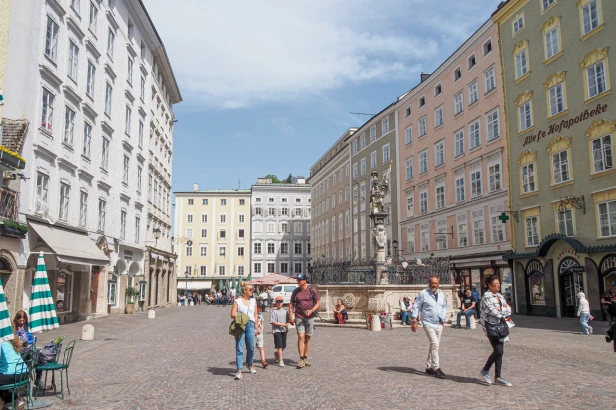
To avoid large crowds, your best time to visit is off season, particularly January to March and October to mid-November. That said, the winter months are usually cold and depending on the weather, some of the destinations might be closed. Also, visiting Mirabell Gardens when it is covered in snow might be a lovely sight, you are often not that lucky during off season and the weather will be simply not ideal to explore the local parks and gardens in all their splendour.
With the weather starting to warm up in spring, a higher number of visitors will start to arrive from around mid-May.
Meanwhile, Salzburg’s festival season kicks off on Easter Weekend when the annual music and opera Easter Festival takes place in the week before Easter, which brings a lot of visitors. However, the largest crowds will arrive from mid-July when the annual Salzburg Festival kicks off, lasting for five weeks and from end-November through to Christmas when the local Christmas Markets are open.
How much time do you need to explore Salzburg
You can easily explore Salzburg in one day. The small historic centre is perfectly walkable, while Mirabelle Garden and Palace is located in easy walking distance just across the Salzach River in Salzburg’s New Town.
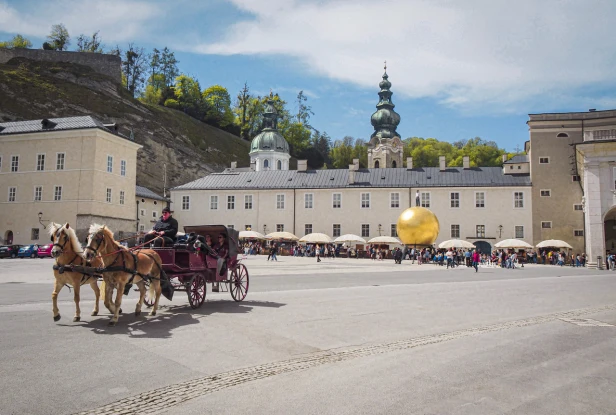
That said, this gorgeous city does offer more than only scenery. Several museums, and many music festivals during the year are more than reason enough to plan a longer stay.
Add the city’s immediate surroundings, Salzburg is a destination that offers plenty of things to do and see for a three-to-four-day visit.
How to get to Salzburg
Salzburg’s main international connection is Salzburg airport. There are daily flights from many major European cities.
The next larger international airports are Vienna in Austria and Munich in Germany. Both are easily reached by train and there are additional train connections to other Austrian cities like Innsbruck and Graz.
Culinary highlights you should not miss visiting Salzburg
If like me, food is an essential part of your travels, the one question popping up each time when visiting a new place is: Are there any traditional regional foods I should try?
Well, in the case of Salzburg, this clearly includes some of the iconic Austrian dishes like Schnitzel, dumplings, and the famous Sacher cake which are served nearly everywhere in the city.
However, if you visit, there are two specific desserts/sweets you should try.
Created in 1890 by local confectioner Paul Fürst, and named after the city’s most famous citizen, there is no escaping the Mozartkugel. It’s on display everywhere in the city where food and confectionary is sold. Originally called Mozart Bonbon, it consists of a round chocolate praline filled with pistachio, marzipan, and nougat coated with a layer of dark chocolate and dusted off with powdered sugar. Today, all bakeries make their own Mozartkugel, and various food brands are making their own versions, not only in Austria. However, if you want to tread yourself to the original, head to Café Fürst, which still exists to this day and still belongs to the Fürst family.
Likewise delicious is the city’s most famous dessert, called Salzburger Nockerl. It is a sweet souffle made from egg yolk, flour, sugar, and vanilla mixed into the dough and egg white and granulated sugar mixed into a meringue added to the dough. The final mixture is shaped into dumplings, which in local dialect translates to nockerl, and baked in the oven until turning golden-brown on the outside. The dessert is served still warm and dusted off with powdered sugar. Most restaurants serving traditional Austrian food will serve Salzburger Nockerl as dessert, or you can try it at the local coffeehouses.
Things to do and see in one day in Salzburg
In case you are planning to visit for the day, or spending the maximum of one night in Salzburg, I’ve put together an easy day-itinerary to explore the city’s main sights without stressing out.
If you plan to stay longer, check out my suggestions of interesting places and things to do in the near surroundings.
Getreidegasse
Salzburg’s main pedestrian street is also the busiest part of the city, located at the heart of the Old Town.

The small pedestrian alley is lined by all sorts of shops, from luxury fashion brands to traditional local artisanal clothes, local handicraft and souvenir shops, chocolate and sweets, and various wine and liquor shops.
The beautiful pastel hued facades are adorned with wrought iron signs which add to the historic atmosphere.
Mozart’s Birthplace
World-famous composer Mozart was born in Salzburg on January 27th, 1756, on the third floor of a stately townhouse right on Getreidegasse. The building itself dates back to the 12th century and today hosts a museum portraying the life and work of its famous resident.
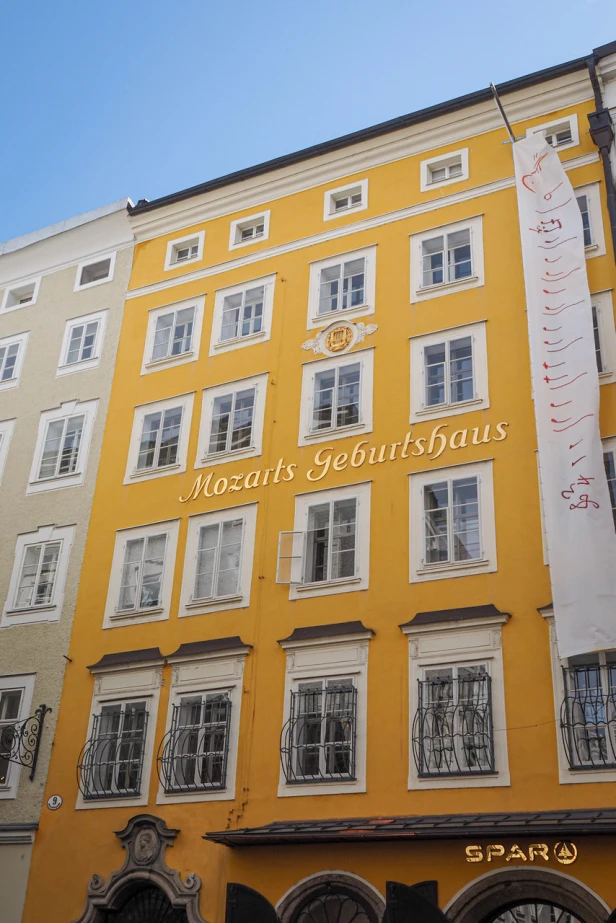
While the yellow façade with the prominent letters is perhaps the most photographed in all of Salzburg, with most visitors keen to get a shot in front of the house, the Mozart family moved to a house in the New Town when after Mozart turned seventeen.
Known as the Mozart Residence, the later home two was converted into museum. It is the one that offers a more comprehensive view into the life of the composer. There is also Mozart’s piano on display.
Residenze Square
Originally called Hauptplatz, which translates into main square, Salzburg’s largest square was given its new name in reference to the Residenze building. Officially called the Alte Residenz (old residence), it once was the home and seat of the prince archbishops.
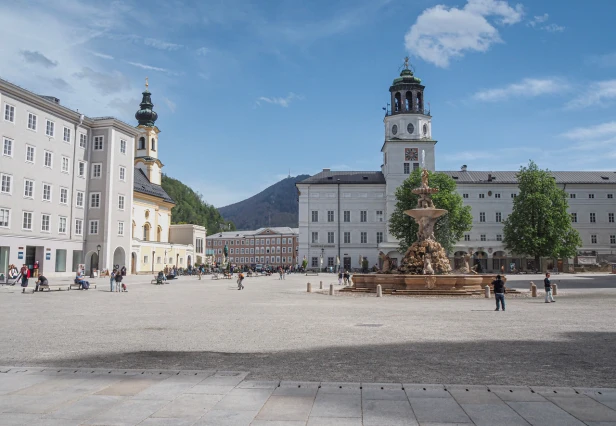
Encircling the square is also the Neue Residenz (new residence) building spotting a beautiful bell tower, a couple of stately town houses, and the Salzburg Cathedral to the south.
The Residenze buildings today host several museums which are interconnected, including an art museum displaying the works of Rembrandt, Rubens, and Brueghel among others.
Residenzbrunnen, the beautiful large fountain right in the middle of the square was designed by Tommaso di Garona and built between 1656 and 1661. Today, it is considered the largest Baroque fountain in Central Europe.
In December, the square transforms into a winter wonderland, hosting the largest Christmas Market in the city.
Dom Square and Salzburg Cathedral
Built in the early 1600s, the stunning cathedral was one of the first Baroque buildings constructed north of the Alps.
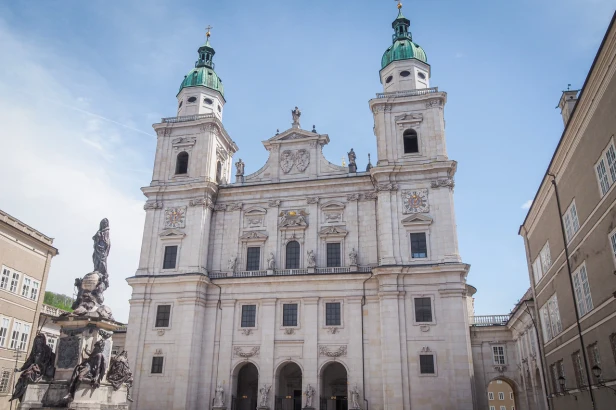
The two prominent towers adorned with copper domes are visible from nearly every part of the city. The façade is adorned with sculptures of saints and angles while inside you will find beautiful frescoes created by Italian artist Ignazio Solari.
By the way, Mozart was baptised in the cathedral, at the fond just inside the front door, and later was the cathedral organist for around one year.
Entrance to the cathedral is 5 euros (at time of writing), and if you want to attend the daily organ concert at noon (except on Sundays and bank holidays), it’s 9 euros. You can also join a 40 minute daily guided tour through the cathedral, which takes place at 2pm and costs 9 euros to attend as well.
Kapitelplatz
Just a few steps away to the other side of the cathedral lies another of the city’s beautiful large squares. It’s name, Kapitelplatz, translated into Chapter Square in English.
The first thing you will notice when stepping through the archway leading to the square is a huge golden ball, which is known as ‘sphere’. Standing on top of it is a tiny man.
A large chessboard is integrated in the ground just next to the globe, and chances are high a match will go on, with more players eagerly waiting for their turn.
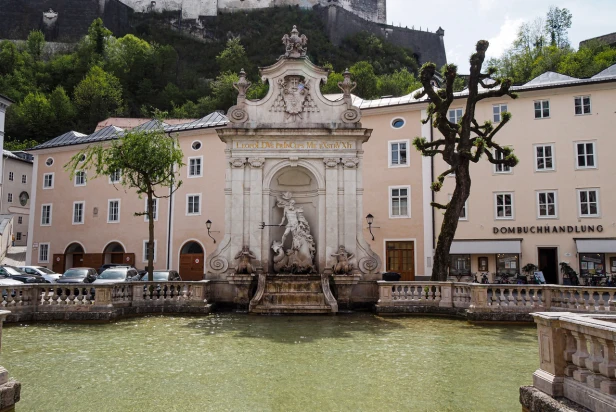
A few steps further into the square you will find the beautiful Neptune fountain, which is officially called ‘Kapitel Schwemme’ and was originally built as a horse pond.
Hohensalzburg Fortress
Towering high above the Old Town is Salzburg’s most spectacular monument. Hohensalzburg Fortress was originally built in 1077 by orders of Archbishop Gebhard and constantly extended and reshaped by his successors. The latest major works which left the castle in its current form took place around 1500. Today the fortress is the largest fully preserved medieval castle in Central Europe.
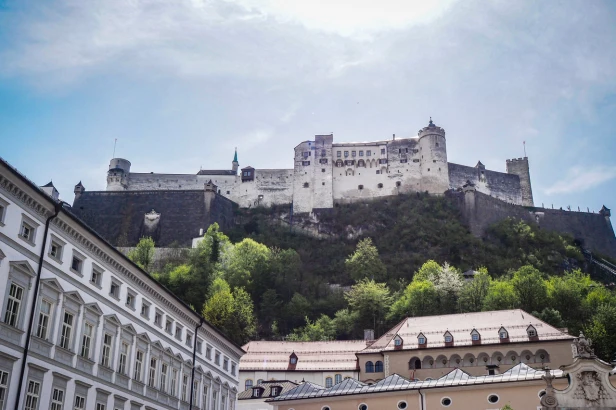
From the top the fortress offers a stupendous 360-degree view over the city and its surroundings. Meanwhile, inside are several museums offering intriguing insight into the life of the past.
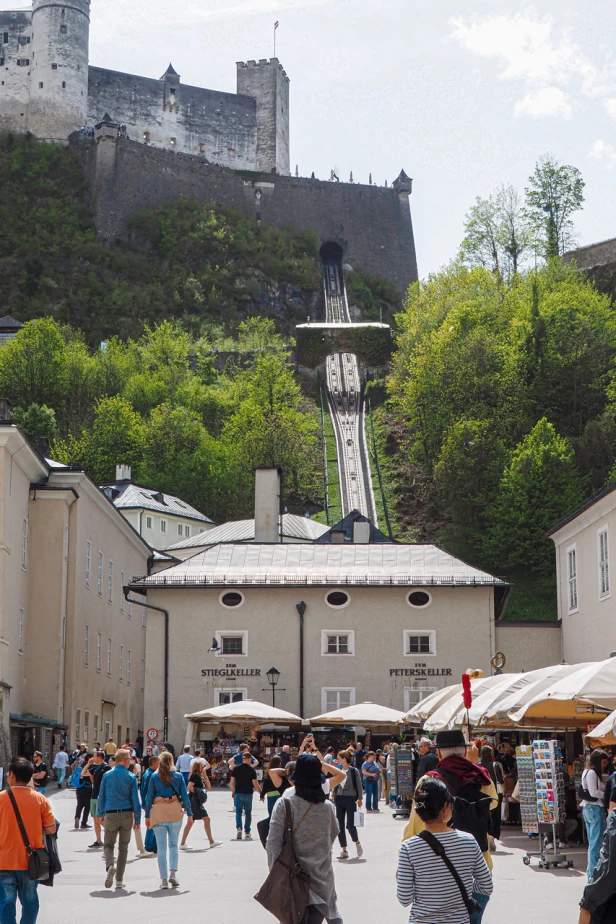
The easiest way to reach the fortress is taking the funicular from Kapitelplatz, though you can also hike up a scenic route.
Have coffee at one of the leading coffee houses
While Vienna brides itself as the original birthplace of Europe’s coffee houses, coffee culture plays an important role all over Austria. Being no exception, Salzburg’s Old Town is home to a number of historic coffee houses worth stopping at for a cup of the delicious beverage.

Café Mozart located directly on Getreidegasse opened its doors in 1923, and while this means the place now looks back at more than 100 years of history, it is rather a newbie of the city’s historic coffee houses.

Café Tomaselli is a great spot to overlook the beautiful Alter Markt square, especially if you manage to get a table on the upstairs balcony. It is not only one of the city’s historic coffee houses. Looking back at a history spanning more than 300 years, it is one of the oldest in Austria, and to this day belongs to the Tomaselli family. Once the Mozart family’s favourite café, it played host to many more famous guests.
Café Fürst, the place where the popular Mozartkugel was created, is located just across Café Tomaselli, still in its original location. Managed by the Fürst family in the 5th generation, this is the place to try the original Mozartkugel, still produced by hand following the original recipe.
Mirabell Garden and Palace
The beautiful Mirabell Garden and Palace is located not far from the historic core of the Old Town, just across the Salzach River.
Dating back to the early 1600s, Mirabell Palace was built by archbishop Wolf-Dietrich von Raitenau as home to his mistress Salome Alt. Originally known as Altenau Palace today the palace and gardens are listed as a cultural heritage monument and part of Salzburg’s Historic Centre UNESCO World Heritage Site.
The beautifully landscaped garden is home to more than hundred different species of plants and flowers, spotting colourful flower arrangements and sculptures along the curated walkways, and offers a stunning view at Hohensalzburg Fortress.
Entrance to the palace and garden is free. That said, only a small portion of the palace is accessible to visitors, as it’s home to government offices.
Mönchsberg
If you still have time, head to iconic Mönchsberg. Named after the monks of St. Peter monastery, the hill rising to around 500 metres at its highest point stretches over some 1.7 kilometres and offers stupendous views over the Old and New Town.
On top of Mönchsberg, the city’s historic defensive wall, originally erected in the 13th century and further extended and reinforeced in 1465, is still fully preserved today.

The easiest way to get on top of Möchsberg is the modern elevator located on Anton-Neumayr-Platz.
Where to stay in Salzburg
If you are looking to spend a night or more in the city, there is no shortage of great hotels.

- Hotel Goldener Hirsch: If it’s good enough for King Charls (although still Prince when staying here) it should be good enough for you. Salzburg’s legendary inn, welcoming guests since the 15th century remains the first address to this day. And sitting right at the beginning of Getreidegasse, you could not be more central than here.
- Hotel Schloss Mönchstein: Perched on top of Mönchsberg, offering stunning views over the city this 16th century castle hotel is a fairytale dream come true.
- Hotel Sacher: No, you are not in Vienna. Though it belongs to the very same family. Among past guests are the Dalai Lama and Tom Hanks.
- Hotel Stein: Nestled right at the shores of Salzach River, this adults-only hotel offers stunning views over the UNESCO-listed Old Town which you can reach in just a few minutes. Located in a 14th century building, this is the city’s oldest inn.
- Amadeus: Set in a 500-year-old restored stately townhouse on Linzer Gasse, is located in easy reach of the main sights within the Old Town, Mirabell Gardens
Where to eat in Salzburg
There is no shortage of excellent places to eat either. From traditional inns serving Austrian food to Michelin-starred restaurants, you won’t leave Salzburg hungry.
- Michelin-starred Glass Garden at Hotel Schloss Mönchstein serves seasonal tasting menus.
- Steinterrasse at Hotel Stein boasts an international menu including pasta and dim sum along with a beautiful view over Salzburg.
- Gasthof Goldgasse: Nestled away in a 700-year-old building on Goldgasse, in the heart of the Old Town, this is the best place if you want to taste traditional local food served with a modern twist.
- Restaurant Goldener Hirsch: Located at Hotel Goldner Hirsch, boasts a mixture of traditional Austrian cuisine and some international-inspired dishes.
The surroundings
If you are planning a longer stay, there is a lot to discover outside the city too. Below is just a short list of the destinations worth exploring.
- Hellbrunn Palace: Located in the Hellbrunn neighbourhood, this 17th century palace was built as a summer residence by Prince-Archbishop of Salzburg. It spots a beautiful Baroque style and curated gardens. However, the most fun are certainly the famous trick fountains featuring hidden streams, water sprays, and surprising waterspouts.
- Salzburg Open Air Museum: Round about 15 minutes by car, located in Großgmain right at the border to Germany, you can admire beautifully preserved historic rural houses and learn all about rural living and farming between the 15th and 19th century at the 50-hectare open air museum.
- Salzkammergut Lake District: Lake Fuschl, Lake Wolfgang and Mondsee (moon lake) are only the top of the crop of the 76 lakes and numerous mountain peaks in this UNESCO World Heritage Site. The area includes the famous town of Hallstatt along with many other small mountain villages and boasts many kilometres of hiking routes.
If you are planning a trip to Salzburg for the first time, don’t miss the major sights and activities of the city listed above. Though, just as always, set your own pace and priorities exploring the city. And don’t worry if you are not able to explore everything in one day (or during one visit). It simply means you have the perfect excuse to return.